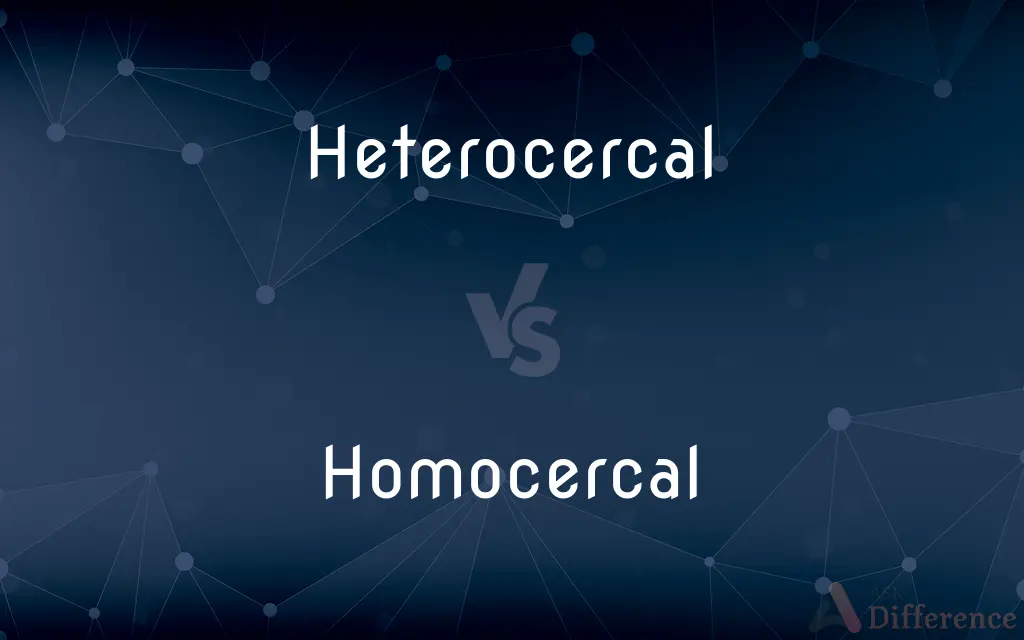Heterocercal vs. Homocercal — What's the Difference?
By Tayyaba Rehman & Fiza Rafique — Updated on April 24, 2024
Heterocercal tails in fish are asymmetrical, aiding in lift during swimming, while homocercal tails are symmetrical, providing propulsion without lift.

Difference Between Heterocercal and Homocercal
Table of Contents
ADVERTISEMENT
Key Differences
Heterocercal tails, found in sharks and some ancient fishes, feature a spine that extends into the upper lobe, making it larger than the lower lobe. This structure aids these fishes in maintaining an upward tilt and buoyancy in the water. On the other hand, homocercal tails, seen in most modern bony fishes, consist of lobes that are generally equal in size, which helps in a more balanced and straightforward swimming motion.
In heterocercal tails, the uneven distribution of the lobes causes a dynamic lift, which compensates for the lack of a swim bladder in many of these species. This anatomical feature is crucial for their survival strategy, enabling them to swim effectively at various depths. Whereas, homocercal tails contribute primarily to forward propulsion, with the symmetrical tail design enhancing speed and maneuverability in the water.
The evolutionary significance of the heterocercal tail is linked to ancient fish lineages, suggesting adaptations to diverse aquatic environments and predatory lifestyles. In contrast, the homocercal tail is more commonly associated with evolved and diverse species of bony fish, supporting a range of ecological niches and methods of survival.
Heterocercal tails often indicate a more primitive or ancestral state within the evolutionary history of fishes. This tail type is typically robust and powerful, ideal for the lifestyle of predatory and bottom-dwelling species. Conversely, homocercal tails are indicative of evolutionary advancements that favor agility and speed, crucial for escaping predators and efficient foraging.
The heterocercal tail can be seen as a functional adaptation that impacts the fish’s body position in water, often aligning it vertically for sudden dives or ascents. Homocercal tails maintain the fish’s horizontal alignment, which is optimal for sustained high-speed pursuit and evasion maneuvers in open water.
ADVERTISEMENT
Comparison Chart
Symmetry
Asymmetrical; upper lobe larger than the lower lobe
Symmetrical; lobes are generally equal in size
Function
Provides lift and assists in vertical swimming
Promotes propulsion and agility in swimming
Evolutionary Significance
Common in ancient and some predatory fishes
Dominant in modern bony fishes
Structural Impact
Aids in maintaining an upward tilt and buoyancy
Keeps the fish balanced and streamlined
Associated Species
Sharks, sturgeons, and other ancient fish
Most modern bony fishes
Compare with Definitions
Heterocercal
Typically found in species lacking a swim bladder.
The heterocercal tail compensates for the absence of a swim bladder in many shark species.
Homocercal
Referring to a symmetrical tail in fish, where the lobes are of equal size.
Trout and bass exhibit homocercal tails that enhance their speed.
Heterocercal
Characteristic of some fish tails where the vertebral column extends into the upper lobe.
Sturgeons exhibit a pronounced heterocercal tail which aids in their slow swimming.
Homocercal
Common feature in modern bony fishes, aiding in precise movements.
The homocercal tail design allows salmon to make sharp turns and rapid escapes.
Heterocercal
Pertaining to a tail with unequal upper and lower lobes.
The shark's heterocercal tail helps it to stabilize and maneuver through the water.
Homocercal
Structurally designed for balanced propulsion and agility.
Predatory fishes leverage their homocercal tail for efficient chasing of prey.
Heterocercal
Indicative of a more primitive or ancestral evolutionary stage in fishes.
The heterocercal tail design in sharks points to their long evolutionary history.
Homocercal
Supports the fish in maintaining a horizontal body position.
The homocercal tail helps maintain stability and control during swimming.
Heterocercal
Evolved primarily for lift and buoyancy in aquatic environments.
The ancient fishes used their heterocercal tails to navigate diverse aquatic terrains.
Homocercal
Evolved to support high-speed pursuits and evasion.
The streamlined form of the homocercal tail is vital for the fast-swimming mackerel.
Heterocercal
Relating to, having, or being a tail fin in which the upper lobe is larger than the lower and the vertebral column extends into the upper lobe, as in sharks.
Homocercal
Relating to, designating, or characterized by a tail fin having two symmetrical lobes extending from the end of the vertebral column, as in most bony fishes.
Heterocercal
(ichthyology) Of a fish's tail, such that the vertebral column bends and extends upwards into the upper lobe of the tail, making it larger than the lower lobe; as in sharks, rays, and skates.
Homocercal
(ichthyology) Describing the symmetric tail of a fish that has two lobes extending from the end of the vertebral column.
Heterocercal
Having the vertebral column evidently continued into the upper lobe of the tail, which is usually longer than the lower one, as in sharks.
Homocercal
Having the tail nearly or quite symmetrical, the vertebral column terminating near its base; - opposed to heterocercal.
Heterocercal
Possessing a tail with the upper lobe larger than the lower and with the vertebral column prolonged into the upper lobe
Homocercal
Possessing a symmetrical tail that extends beyond the end of the vertebral column (as in most bony fishes)
Common Curiosities
Which types of fish typically have homocercal tails?
Most modern bony fishes, including trout, bass, and salmon, have homocercal tails.
Are homocercal tails more evolved than heterocercal tails?
Homocercal tails are considered more evolved, generally associated with advanced swimming capabilities and adaptation to diverse environments.
Do all sharks have heterocercal tails?
Most sharks have heterocercal tails, although the degree of asymmetry can vary among species.
What is the main functional difference between heterocercal and homocercal tails?
Heterocercal tails provide lift and help in vertical swimming, whereas homocercal tails are more about propulsion and agility.
Why do sharks have heterocercal tails?
Sharks have heterocercal tails to help maintain buoyancy and enable effective maneuvering and stabilization in the water.
How does the structure of a heterocercal tail affect a fish’s swimming?
The asymmetrical structure of a heterocercal tail aids in vertical positioning and can help a fish dive or rise in the water.
Is there a correlation between the type of tail and the habitat of a fish?
Yes, tail type often correlates with habitat and lifestyle; heterocercal-tailed fish are commonly bottom dwellers or deep-water species, while homocercal-tailed fish are often found in varied and often shallower waters.
Can a fish with a heterocercal tail swim as fast as one with a homocercal tail?
Generally, heterocercal tails are not designed for speed as much as homocercal tails, which promote faster and more agile movement.
What evolutionary advantage does a homocercal tail provide?
The homocercal tail offers evolutionary advantages in speed, agility, and energy efficiency in swimming.
Are there any freshwater fishes with heterocercal tails?
Yes, sturgeons are an example of freshwater fishes that have heterocercal tails.
Which tail type is more common in predatory fishes?
Predatory fishes commonly exhibit homocercal tails, which assist in quick and agile movements necessary for catching prey.
Do homocercal tails help in better maneuverability compared to heterocercal tails?
Yes, the symmetrical design of homocercal tails allows for better control and maneuverability.
How does the tail structure affect the dietary habits of fishes?
Tail structure can influence swimming behavior and thus affect how a fish hunts or evades predators, impacting its dietary habits.
How does the vertebral column influence the shape of the tail in heterocercal and homocercal tails?
In heterocercal tails, the vertebral column extends into the upper lobe, affecting the tail’s asymmetry; in homocercal tails, it ends at the base of the tail, maintaining symmetry.
What are the biomechanical challenges associated with each tail type?
Heterocercal tails face challenges in maintaining horizontal stability, while homocercal tails must optimize for energy-efficient propulsion and speed.
Share Your Discovery

Previous Comparison
Penicillin vs. Penicillium
Next Comparison
Box vs. CubeAuthor Spotlight
Written by
Tayyaba RehmanTayyaba Rehman is a distinguished writer, currently serving as a primary contributor to askdifference.com. As a researcher in semantics and etymology, Tayyaba's passion for the complexity of languages and their distinctions has found a perfect home on the platform. Tayyaba delves into the intricacies of language, distinguishing between commonly confused words and phrases, thereby providing clarity for readers worldwide.
Co-written by
Fiza RafiqueFiza Rafique is a skilled content writer at AskDifference.com, where she meticulously refines and enhances written pieces. Drawing from her vast editorial expertise, Fiza ensures clarity, accuracy, and precision in every article. Passionate about language, she continually seeks to elevate the quality of content for readers worldwide.














































